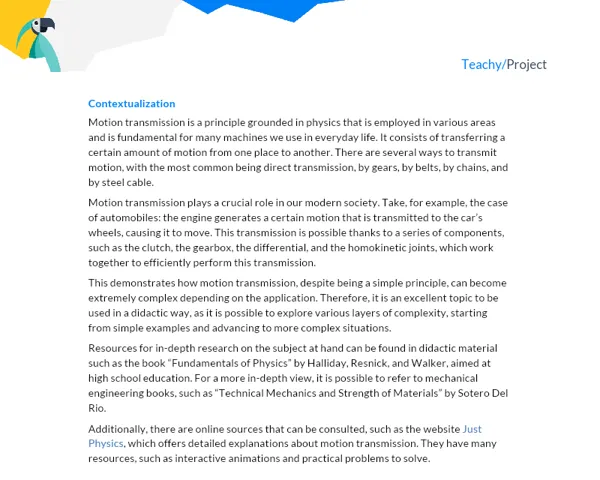Background
The study of wave phenomena is one of the most interesting topics in physics. One of these phenomena is the speed of the waves, a fundamental concept to understand how the waves move. The waves can be basically classified into: mechanical waves, which require a material medium to propagate (waves on ropes, sound waves, sea waves, etc.) and electromagnetic waves, which do not need a material medium to propagate (light, X-rays, radio waves, etc.).
In Physics, the speed of the waves refers to the distance that a wave travels in a unit of time. To calculate this speed, we use the formula v = λf, where v is the speed, λ is the wavelength and f is the frequency of the wave. The frequency of a wave refers to the number of oscillations that the wave makes in a certain interval of time, while the wavelength is the distance between two consecutive identical points in a wave.
To expand your theoretical understanding of the topic, we recommend reading the corresponding chapters in the following books: "Fundamentals of Physics", volumes 2 and 3, by David Halliday and Robert Resnick, and "Physics for Scientists and Engineers, volume 1", by Paul A. Tipler. These books are references in the area and present a didactic approach to the topic.
Relevance of the study of the Speed of Waves
The speed of the waves plays a crucial role in several areas of our daily life and in the world of science and technology. For example, in telecommunications, information is transmitted in the form of electromagnetic waves. The speed of propagation of these waves determines how fast the information is transmitted. Similarly, radars use the reflection of electromagnetic waves to detect the location and speed of distant objects.
In medicine, ultrasound equipment uses the principle of sound waves with high frequency to create images of organs inside the human body. The study of waves is also fundamental in quantum physics, where particles are often described as probability waves.
The speed with which seismic waves propagate through the Earth provides us with important information about the internal structure of our planet, being essential for seismology. Furthermore, the speed of light waves allows us to estimate astronomical distances and understand the expansion of the universe.
Therefore, this project will seek to explore in a practical and theoretical way the concept of the speed of waves, providing you with a deep and applied understanding of this fundamental topic in physics.
Practical Activity: Waves in the Pool
Objectives of the Project
The objective of this project is to analyze the speed of propagation of waves in a liquid medium (water), using a swimming pool as an experimental environment. To do this, you will need to create waves of different frequencies and measure the speed of propagation of these waves. The ultimate purpose is to understand how frequency and wavelength relate to the speed of the wave through the principle of wave motion.
Detailed Description of the Project
You and your group will conduct experiments in a swimming pool to study the speed of wave propagation. You will create waves of different frequencies, measure the length of these waves, and finally calculate their speed. It will be necessary to document the entire process and results obtained to include in the final report.
Please keep in mind that safety is our priority. Follow all safety guidelines around the pool, and only conduct the experiment if there is an adult supervising.
Materials Required
- 1-meter ruler or measuring tape
- Stopwatch
- A swimming pool
- Video camera (optional)
Detailed step-by-step to carry out the activity
1. Planning
The group should meet to study the concept of wave speed and plan to conduct the experiment. At this stage, you should define the process of generating waves in the pool and the methodology for measuring the variables of the experiment.
2. Conducting the experiment
On the day of the experiment, follow the steps below:
- Fill the pool with water to a safe depth.
- Near the edge, generate a wave in the water. You can do this by swinging an object in the water or hitting the surface of the water with your hand.
- Use the stopwatch to measure the time it takes for the wave to cross the pool.
- Measure the length of the pool (the distance the wave traveled).
- Repeat the process for waves of different frequencies. Remember, to change the frequency of the waves, you can change the speed at which you stir the water.
3. Data analysis
From the data collected, you must:
- Calculate the speed of each wave using the formula v = λf.
- Analyze if there is a relationship between the frequency of the waves and their speed.
4. Documentation
Record the entire process of experimentation and data analysis. Take pictures and videos of the process, if possible. Document all your observations and results.
5. Preparation of the final report
Using the data collected and the observations made, you should prepare a final report presenting your project. The report should follow the proposed structure:
- Introduction: Contextualize the theme, explain its relevance and the objective of the project.
- Development: Include the theory on wave speed and explain the activity in detail, indicating the methodology used and the results obtained.
- Conclusions: Conclude the work by revisiting your main points, explaining the lessons learned, and the conclusions drawn about the project.
- Bibliography: Indicate the sources that you used to base yourself on during the project.
Remember, the report is a fundamental part of the project, it is through it that you record your findings and share your results. Adapt it throughout the development of the project and always be willing to learn and investigate more!


